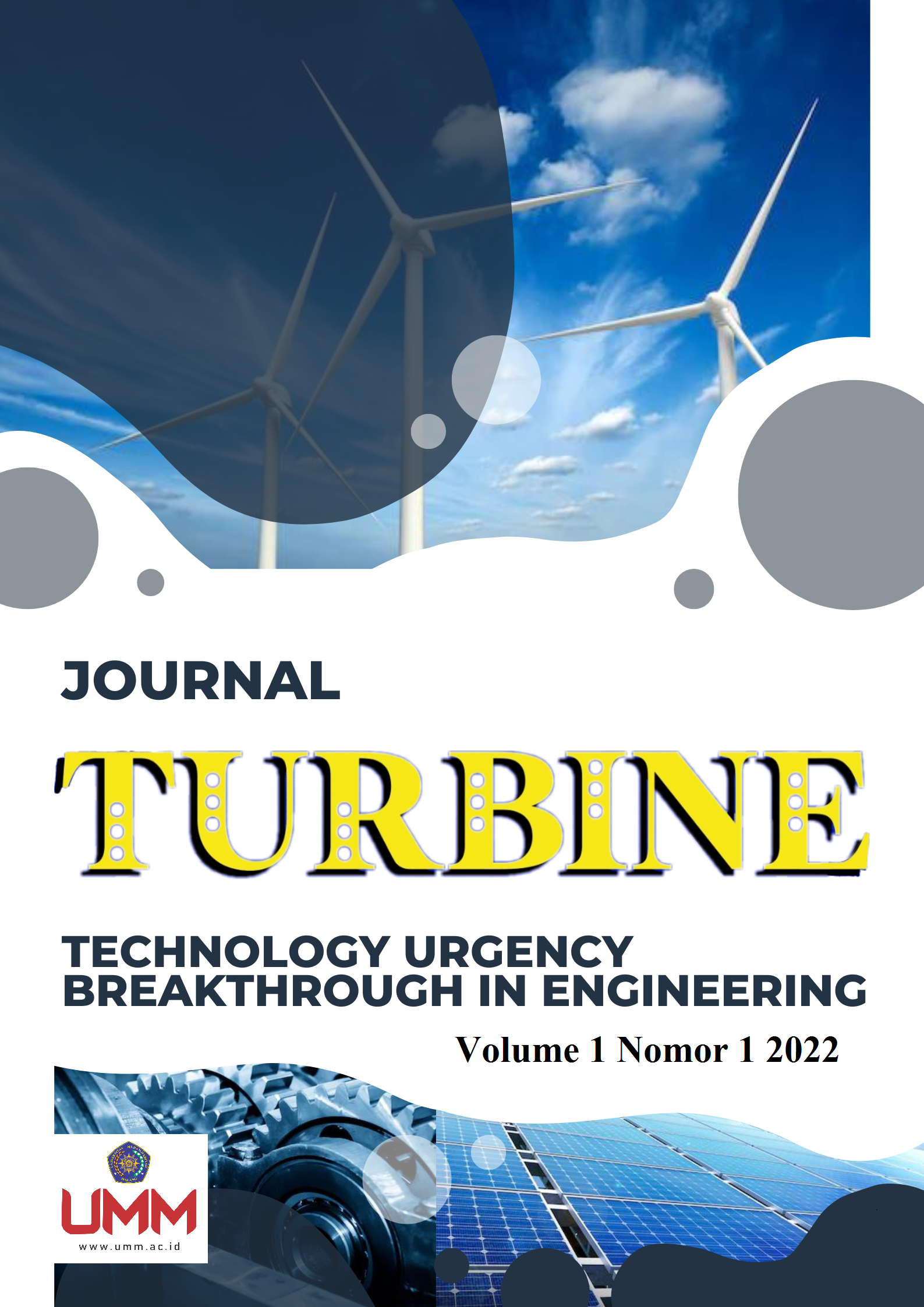Pengaruh Fraksi Berat Dan Bentuk Serat Pisang Abaka (Musa Textilis) Terhadap Kekuatan Impak Pada Proses Pembuatan Komposit Menggunkan Metode Vacuum Infusion
Keywords:
Komposit, Material, Pisang Abaka, Vacuum InfusionAbstract
Materials are growing day by day, one of the most widely used materials is composite material, a composite is a material formed from a mixture of two or more forming materials through an inhomogeneous mixture, where the mechanical properties of each forming material are different. The focus of this research is to utilize abaca fiber to be used as a composite material using a polyester matrix. The manufacturing method used is the vacuum infusion method. The purpose of this study was to determine the impact strength of composites with chopped and intact banana fiber filler with a weight fraction of 10%, 20% and 30%. The highest impact value in this study obtained an average impact value of 0.523 Joule/mm2 at 30% weight fraction variation with chopped fiber, while the lowest value got an average impact value of 0.071 Joule/mm2 at 30% weight fraction with intact fiber. This shows that the 2 variations in weight and shape of the fiber with abaca fiber filler based on this research affect the value of impact strength.
Downloads
References
T. Yuliyono, H. Purwanto, and S. M. B. Respati, “KARAKTERISASI KOMPOSIT MATRIK RESIN EPOXY BERPENGUAT SERAT GLASS DAN SERAT PELEPAH SALAK DENGAN PERLAKUAN NaOH 5%,” J. Ilm. Momentum, vol. 5, no. 3, pp. 248–253, 2020.
D. K. Rajak, D. D. Pagar, R. Kumar, and C. I. Pruncu, “Recent progress of reinforcement materials: A comprehensive overview of composite materials,” J. Mater. Res. Technol., vol. 8, no. 6, pp. 6354–6374, 2019, doi: 10.1016/j.jmrt.2019.09.068.
Z. Zulkifli, H. Hermansyah, and S. Mulyanto, “Analisa Kekuatan Tarik dan Bentuk Patahan Komposit Serat Sabuk Kelapa Bermatriks Epoxyterhadap Variasi Fraksi Volume Serat,” JTT (Jurnal Teknol. Terpadu), vol. 6, no. 2, p. 90, 2018, doi: 10.32487/jtt.v6i2.459.
A. Karimah et al., “A review on natural fibers for development of eco-friendly bio-composite: characteristics, and utilizations,” J. Mater. Res. Technol., vol. 13, pp. 2442–2458, 2021, doi: 10.1016/j.jmrt.2021.06.014.
A. Hartono and P. B. H. Janu, “Pelatihan Pemanfaatan Limbah Kulit Pisang Sebagaibahan Dasar Pembuatan Kerupuk,” J. Inov. dan Kewirausahaan, vol. 2, no. 3, pp. 198–203, 2013, [Online]. Available: https://journal.uii.ac.id/ajie/article/view/7878.
M. Maftuhatin, Y. Indrayani, and A. Yani, “SIFAT FISIK DAN MEKANIK PAPAN SERAT BATANG PISANG KEPOK (Musa paradisiaca. L) PADA BERBAGAI SUHU DAN WAKTU KEMPA (Physical and Mechanical Properties of a Fibre Board Made from Kepok Banana Stem (Musa Paradisiaca L) at Various Pressing Temperatures and Tim,” vol. 5, no. 3, pp. 721–731, 2017.
Najamudin, “Pengaruh Ukuran Partikel Terhadap Sifat Mekanik Komposit Dengan Matrik Resin Epoxy,” 2017.
H. Wona, K. Boimau, E. U. K. Maliwemu, J. T. Mesin, and U. N. Cendana, “Pengaruh Variasi Fraksi Volume Serat terhadap Kekuatan Bending dan Impak Komposit Polyester Berpenguat Serat Agave Cantula atau lebih gabungan konstituen yang dan tidak larut dalam satu sama lain . Salah,” vol. 02, no. 01, pp. 39–50, 2015.
Y. Handono, “PERANCANGAN ALAT UJI IMPAK METODE CHARPY KAPASITAS 100 JOULE,” 2013.
I. P. G. Suartama, I. N. P. Nugraha, and K. R. Dantes, “Pengaruh Fraksi Volume Serat Terhadap Sifat Mekanis Komposit Matriks Polimer Polyester Diperkuat Serat Pelepah Gebang,” J. Pendidik. Tek. Mesin Undiksha, vol. 4, no. 1, 2020, doi: 10.23887/jjtm.v4i1.8312.
D. Wijaya and S. Hidayat, “Pengaruh Fraksi Volume Serat pada Komposit Hibrid Serat Tebu dan Serat Sabut Kelapa terhadap Kekuatan Tarik,” Pros. 13th Ind. Res. Work. Natl. Semin. Bandung, pp. 78–83, 2022.
M. A. Ilmy, S. Junus, and A. A. Rosyadi, “Pengaruh Fraksi Volume Fiber Glass Terhadap Sifat Mekanik Komposit Fiber Glass / Epoxy Dengan Metode Vari,” J. STATOR, Vol. 1 Nomor 1, Januari, vol. 1, pp. 10–15, 2018.
R. E. W. Susanto, M. Maskuri, and S. Arif, “Pengaruh Serat Agave Sisal Terhadap Kekuatan Impak dan Tekan Komposit Nilon Termoplastik Gliserol,” J. Tecnoscienza, vol. 6, no. 1, pp. 151–164, 2021, doi: 10.51158/tecnoscienza.v6i1.603.
M. Lubis and F. B. Harahap, “Tensile Strength Properties of Rice Husk-Rice Husk Ash Filled Plastic Drinking Bottle Waste Hybrid Composite with the Addition of Glycerol as Plasticizer,” Int. J. Sci. Res., vol. 5, no. 5, pp. 612–616, 2015, doi: 10.21275/v5i5.nov163445.
A. Nurdin, S. Hastuti, H. P. D., and R. H., “Pengaruh Alkali dan Fraksi Volume terhadap Sifat Mekanik Komposit Serat Akar Wangi – Epoxy,” Rotasi, vol. 21, no. 1, p. 30, 2019, doi: 10.14710/rotasi.21.1.30-35.
K. Boimau, A. Seran, W. Bunganaen, and R. N. Selan, “Efek Panjang Serat Terhadap Sifat Tarik Komposit Poliester Berpenguat Serat Buah Lontar Yang Diberi Perlakuan Alkali,” vol. 5, no. 1, pp. 129–140, 2022.
H. Bisaria, M. K. Gupta, P. Shandilya, and R. K. Srivastava, “Effect of Fibre Length on Mechanical Properties of Randomly Oriented Short Jute Fibre Reinforced Epoxy Composite,” Mater. Today Proc., vol. 2, no. 4–5, pp. 1193–1199, 2015, doi: 10.1016/j.matpr.2015.07.031.
P. Bismantolo, H. Hestiawan, F. Wardhani, and M. F. Utama, “Pemanfaatan limbah tandan buah kosong kelapa sawit sebagai penguat komposit untuk diaplikasikan sebagai bahan baku outer shell helm Standar Nasional Indonesia (SNI),” Din. Tek. Mesin, vol. 12, no. 1, p. 61, 2022, doi: 10.29303/dtm.v12i1.498.
H. P. S. A. Khalil, H. D. Rozman, H. Ismail, and M. N. Ahmad, “Polypropylene (PP)- Acacia mangium composites: The effect of acetylation on mechanical and water absorption properties,” Polym. - Plast. Technol. Eng., vol. 41, no. 3, pp. 453–468, 2002, doi: 10.1081/PPT-120004362.
Y. Zamzami, S. Savetlana, G. Akhyar Ibrahim, and M. Jurusan Teknik Mesin, “Pengaruh Ukuran Fly Ash Pada Kekuatan Bending Komposit Resin Epoxy,” J. Fema, vol. 1, no. 4, pp. 49–52, 2013.
M. Radifan, “ANALISA NILAI KEKUATAN IMPAK PADA KOMPOSIT SERAT PISANG ABAKA BERMATRIK POLYESTER DENGAN VARIASI PRESENTASE VOLUME SERAT,” pp. 1–4, 2020, [Online]. Available: http://eprints.umm.ac.id/id/eprint/87923.
C. B. Wiranegara, X. Salahudin, and S. Hastuti, “Pemanfaatan Serat Alam Dan Serat Sintetis Sebagai,” vol. 5, no. 2, pp. 30–37, 2022.
Downloads
Published
Issue
Section
License
Copyright (c) 2023 Muhammad Alif Akbar Firmansyah, Dini Kurniawati, Mulyono

This work is licensed under a Creative Commons Attribution-NonCommercial 4.0 International License.




